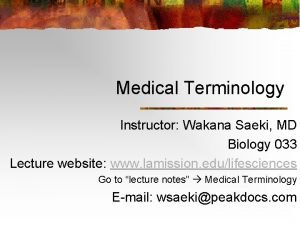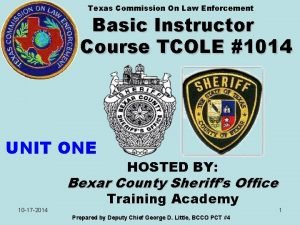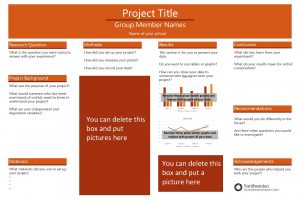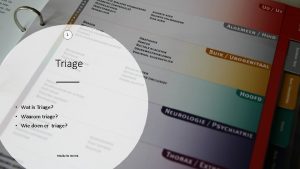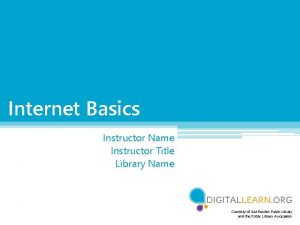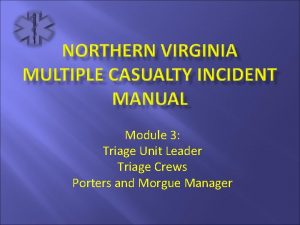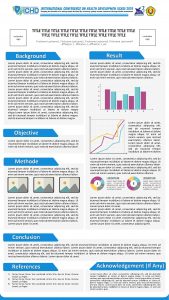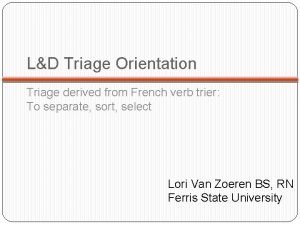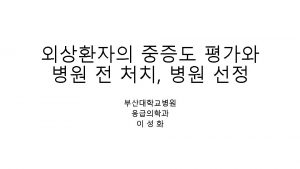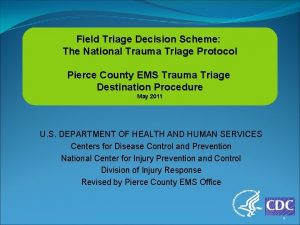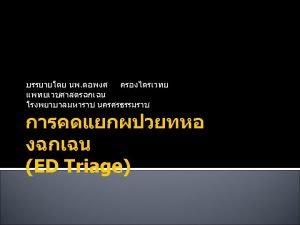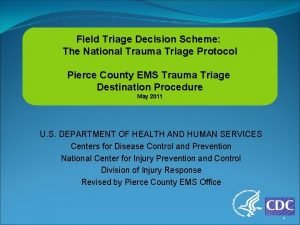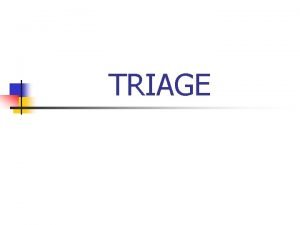Triage Instructor Name Title Unit Triage from the




















































































- Slides: 84

Triage Instructor Name: Title: Unit:

Triage – from the French sort • In casualty management sorting of a large number of injured personnel is the 1 st stage in establishing order • Triage sets the stage for treatment and eventuates in transport of the injured

Triage is not to be considered with finality • Triage categories change based upon – Number of injured – Available resources – Nature and extent of injuries(s) – State of hostile threat

Things change • Number of patients • Extent of resources • Condition of patient – Gets better – Gets worse – Transport arrives

If you have only 1 patient • That patient is Pri 1 Immediate regardless of anything else • There is no real need for triage • Once this number increases, the need for triage arises

Categories • Immediate – Threat to life/limb • A lightly injured is immediate if he can be returned to duty with immediate simple management

Urgent • Patient is at risk if treatment or transportation is delayed unreasonably

Delayed • No risk to life or consequence if more definitive care is not rendered quickly

Expectant • Regardless of the level of care rendered, patient is likely to expire • Tough call to make for unit personnel

START – triage technique • Simple treat/triage and rapid transport • All of you within the sound of my voice – Move towards me – Doesn’t work well in no/low light or excess noise

Military Triage Instructor Name: Title: Unit: COL Cliff Cloonan Assistant Professor Military & Emergency Medicine Department

Triage • Objectives – Upon completion of this block of instruction the student will be able to:

Oklahoma City Federal Building Bombing

Oklahoma City Federal Building Bombing

Triage • Definition – – “To Sort” – From the French word, “trier” – Has been defined as “doing the greatest good for the greatest number” BUT triage is simply a sorting PROCESS that when applied creates a situation that allows for “doing the greatest good for the greatest number”

Triage • What are the OBJECTIVES of doing Triage? – Rapid sorting of the more serious patients from those less serious to facilitate the rapid care of the more serious patients – When problems exceed resources, triage should facilitate “doing the greatest good for the greatest number” – Bring order to chaos thus facilitating the care of all patients

Triage • What is the PROCESS? – Sorting into categories for evacuation and treatment • What are the DECISIONS? – How will the patients be sorted – who goes in which category? – What will be done to/with the patients when sorted? • What factors AFFECT/CHANGE the decisions? – Resources – Circumstances

Triage “Normal” Triage in an ED Sorting Patients TRIAGE - A CONTINUUM Triage in A MASCAL Situation Special Situations • Persisting threat to providers/patients • “Reverse” Triage Situation

“Normal” Triage in an ED TRIAGE - A CONTINUUM Triage in A MASCAL Situation

Triage • “Military” Disasters Occur In Civilian Settings

Triage • And… “Civilian” disasters occur in military settings

Truck Accident on Pipeline Rd Saudi Arabia – Desert Shield

Resource Modifiers (Manpower, Equipment, Expendables, Time) INPUT (Patients to be sorted) Disease Process Modifiers (Illness, Injury, NBC, etc) Triage Situation Modifiers (Risk, Weather, MET-T, Combat Situation, etc…) OUTPUT (Sorted Patients) Immediate Delayed Evacuation Minimal Modifiers Expectant (Assets, Distance, Threat)



Triage • Military vs. Civilian – Are there differences? – Continuing risk to medical care providers • Can occur in both situations • More common in combat/military triage – Resource limited • Can occur in both situations • More common in combat/military triage – “Reverse” Triage Situation • Care provided first to those who when treated can be quickly returned to duty • Usually only in a military situation but could occur in a civilian MASCAL situation (when “Group” survival is at stake)

Civil War Casualty Collection Point

Civil War Casualty Collection Poin and Treatment Station

Vietnam – Mass Heat Casualties

MASCAL Exercise

TRIAGE - A DYNAMIC NOT A STATIC PROCESS

WITHIN THE MILITARY ECHELONED MEDICAL CARE SYSTEM, TRIAGE OF CASUALTIES OCCURS (OR SHOULD), AT A MINIMUM, AT EVERY ECHELON

MILITARY TRIAGE OFTEN INCLUDES, BUT IS MORE THAN, MEDICAL PRIORITIZATION

APPROPRIATE MEDICAL PRIORITIZATION AND TREATMENT OF INJURIES IN A SINGLE PATIENT IS THE GOAL OF ADVANCED TRAUMA LIFE SUPPORT TRAINING

What is the Priority Injury? What is the Triage Category? What is the Evac Priority? RPG Wound Right Knee - Somalia

What is the Priority Injury? What is the Triage Category? What is the Evacuation Priority? Burn Victim - Kosovo

Burn Victim - Kosovo

SURGICAL PRIORITIZATION, WHICH, PRIMARILY INVOLVES A DETERMINATION OF OPERATIVE PRIORITY, IS NOT TRIAGE

Triage • Surgical Prioritization Involves – Recognizing • Which patients require surgery to save life/limb/sight – Knowing • Numbers of OR’s, doctors, nurses, expendables, blood (Resources) each operation requires • Resources (manpower, equip, expendables, blood etc) required to provide post-op care • How long each operation will take (Time as a resource) • The resources that each operation will consume (Must consider manpower as a consumable resource) • Probability of successful surgery

Triage • The Goal of Surgical Prioritization – Selection of cases with the highest probability of success that consume the least amount of resources. – Make a decision - - and go with it! • Once a MASCAL situation has been declared don’t wait for the situation to evolve further before making a decision. • Making decisions is more important than what decisions are made. – Respect the Triage Decision

Grenade Fragment Wound – Perforating Bowel -ICRC Hospital Afghanistan

Transverse Abdominal High Velocity Bullet Wound -ICRC Hospital Afghanistan

Triage • Triage Categories used in ICRC Hospitals – Category I – Priority for Surgery • Patients who need urgent surgery and who have a good chance of satisfactory recovery – Category II – No Surgery • Patients with wounds so slight that they do not need surgery AND… • Patients who are so severely injured that they are unlikely to survive – Category III – Can Wait For Surgery • Patients who need surgery but not urgently

TRIAGE IN A DISASTER IS A MULTIDISCIPLINARY PROCESS. IT IS BEST CARRIED OUT BY SOMEONE WHO IS FAMILIAR WITH: • SURGICAL, MEDICAL, AND PSYCHIATRIC EMERGENCIES • ALL THE PRE-HOSPITAL AND HOSPITALBASED MEDICAL AND LOGISTICAL RESOURCES NECESSARY TO EVACUATE AND PROVIDE CARE FOR A LARGE NUMBER OF CASUALTIES

BY DEFINITION, TRIAGE IN A DISASTER / MASCAL SITUATION MEANS THAT LESS THAN THE NORMAL STANDARD OF CARE WILL BE PROVIDED FOR MANY PATIENTS.

EXAMPLE: FAILURE TO PROVIDE COMPLETE CONTROL OF THE CERVICAL SPINE IN A PATIENT WITH MULTIPLE BLUNT TRAUMA INJURIES IS CONSIDERED MALPRACTICE

EXAMPLE COMPLETE CERVICAL SPINE IMMOBILIZATION IS VERY TIME AND RESOURCE CONSUMING. THE TIME AND RESOURCES REQUIRED TO STABILIZE A CERVICAL SPINE MAY MEAN THAT OTHERS MAY DIE.

ADHERING TO THE PRINCIPLE OF DOING THE GREATEST GOOD FOR THE GREATEST NUMBER MAY REQUIRE THAT LESS THAN FULL CERVICAL SPINE IMMOBILIZATION BE PERFORMED

REMEMBER IF IT WASN'T ALL "SCREWED" UP IT WOULDN'T BE A DISASTER

REMEMBER NOT ONLY MAY CHANGES IN A PATIENT'S MEDICAL CONDITION RESULT IN A CHANGE IN HIS / HER TRIAGE CATEGORY BUT A CHANGE IN AVAILABLE RESOURCES MAY ALSO RESULT IN A CHANGE IN TRIAGE CATEGORY

CAN YOU THINK OF A SITUATION WHERE IT WOULD EVER BE APPROPRIATE TO NEGLECT THE MANAGEMENT OF THE MOST SERIOUSLY WOUNDED IN ORDER TO TREAT THOSE WITH MORE MINOR INJURIES?

REMEMBER A TRIAGE SITUATION IS NOT DETERMINED BY A SET NUMBER OF PATIENTS BUT RATHER BY A MISMATCH OF RESOURCE REQUIREMENTS WITH RESOURCE AVAILABILITY. A TRIAGE SITUATION MAY EXIST WHEN THERE ARE ONLY TWO PATIENTS

THE DECISION TO NOT RESUSCITATE A CRITICALLY INJURED PATIENT WHEN THERE ARE RESOURCES AVAILABLE TO DO SO IS NOT THE SAME AS PLACING A PATIENT IN THE EXPECTANT CATEGORY IN A DISASTER SITUATION

Triage • MILITARY TRIAGE DECISIONS ARE INFLUENCED BY: – NUMBERS OF PATIENTS AND THEIR MEDICAL PROBLEMS – NUMBERS OF EXPENDABLE AND NONEXPENDABLE MEDICAL SUPPLIES AND CAPABILITIES OF MEDICAL TREATMENT FACILITIES – NUMBERS AND CAPABILITIES OF MEDICAL PERSONNEL

Triage • MILITARY TRIAGE DECISIONS ARE INFLUENCED BY(CONT): – NUMBERS AND CAPABILITIES OF EVACUATION ASSETS – TACTICAL SITUATION – WEATHER – OTHER

TERMINOLOGY CIVILIAN USE OF THE WORD "TRIAGE" IS OFTEN NOT THE SAME AS THE MILITARY USE OF TRIAGE

IN A MULTI-CASUALTY INCIDENT WHERE THERE ADEQUATE RESOURCES THE GOAL IS TO RAPIDLY AND EFFICIENTLY IDENTIFY PATIENT NEEDS AND THEN TO MATCH THE RESOURCES WITH THE PATIENTS WHO REQUIRE THEM

IN A DISASTER SITUATION WHERE THERE ARE LIMITED RESOURCES THE GOAL IS TO IDENTIFY PATIENT NEEDS AND THEN TO DISTRIBUTE THE RESOURCES IN A MANNER THAT PROVIDES THE BEST CARE FOR THE MOST POSSIBLE PATIENTS

PROBLEMS WITH STANDARD TRIAGE TAGS

DON'T CONFUSE TRIAGE CATEGORIES WITH EVACUATION PRIORITIES

Triage • EVACUATION PRIORITIES – PRIORITY I – URGENT EVACUATION WITHIN 2 HOURS – PRIORITY IA - URGENT SURGICAL EVACUATION TO NEAREST SURGICAL FACILITY WITHIN 2 HOURS – PRIORITY II – PRIORITY EVACUATION WITHIN 4 HOURS – PRIORITY III – ROUTINE EVACUATION WITHIN 24 HOURS – PRIORITY IV - CONVENIENCE

MASS CASUALTY TEACHING POINTS

MASCAL • Field Response – What / Who do you send to the disaster site? • Equipment – Type – Stick with the basics » Dressings » Backboards/litter with straps » Tourniquets » Airways / suction devices – Quantity (lots) • Personnel – Type (Surgeon, EM…)(MD, Nurse, PA, EMT-P…) – Quantity

MASCAL • Actions on the scene – Safety and site security FIRST – Survey the scene • Estimate number and type of casualties quickly • Transmit brief initial report to Med Tx Facility • Request additional equipment (#/type) and personnel (#/type) as required

MASCAL • Actions on the scene (cont) – Quickly choose a casualty collection point based upon: • • Proximity to patients Proximity to potential helicopter landing site Safety – Distance from potential hazards, secure Geography – Large enough and appropriate for conduct of Geographic Triage) Separate sites for – – – Immediate (next to transportation) Delayed Minimal Expectant Deceased (out of sight of other victims)

MASCAL • Actions on the scene (cont) – Collect all ambulatory patients at CCP by instructing them to walk to CCP • These patients are mostly in the minimal category although some may be delayed • What they are NOT is in the Immediate / Expectant (except in some burn cases) / Dead categories

MASCAL • Actions on the scene (cont) – Put one of the “walking wounded” in charge of ambulatory patients if limited manpower at scene • Most important responsibility is to maintain accountability and keep patients from leaving CCP – If more than one medical responder divide the scene into areas of responsibility and proceed to rapidly assess / treat / triage all remaining patients who were unable to walk to the CCP

MASCAL • Actions on the scene (cont) – Initially treat ONLY readily correctable airway problems and obvious external, potentially lifethreatening, bleeding – No treatment for pulseless /apneic patients. – Place comatose patients in lateral decubitus position – then move on – Apply triage tag to identify location in CCP where patient is to be taken

MASCAL • Actions on the scene (cont) – Have non-medical bystanders and uninjured or minimally injured patients at the scene act as litter bearers (at least one experienced litter bearer / team) and move patients to CCP – Triage Officer at CCP sorts (“triages”) patients into separate geographic location based on tags • Performs rapid reassessment and changes triage category as required

MASCAL • Actions on the scene (cont) – Move rapidly from one patient to next – only identify and if possible quickly treat life threats – Identify ALL patients – Avoid becoming involved in prolonged procedures – Avoid becoming distracted by distraught, minimally injured patients – Pay attention to administrative concerns – Keep track of ALL patients (Trust me – you’ll be glad you did)

MASCAL • Actions on the scene (cont) – Transportation Considerations / Decisions • Do you put all immediate patients on the first available ambulance? • Do you send one of your health care providers if there is no medical care on the transport • To what facility do you send the ambulance? – Travel time – Level I, III trauma center? • Do you wait for a helicopter? • How secure is the route of travel?

MASCAL • Medical Treatment Facility Actions – Maintain Communication with the response team • Identify the scope of the problem • Identify the need for additional resources at the scene – – Medical Security Administrative Transportation – Ground / Air – Arrange for helicopter transportation as appropriate

MASCAL • Medical Treatment Facility Actions (cont. ) – Notify higher HQ and other medical facilities of the situation and request that they standby – Activate Medical Treatment Facility disaster response plan • Call in additional staff / keep staff in hospital at end of shift • Clear receiving area of all stable patients and set up additional beds as required • Cancel any non-emergent surgery • Clear OR’s ASAP • Prepare hospital beds – Request higher echelons preposition ambulance at your medical treatment facility.

MASCAL – Major Teaching Points • When ability to provide medical care is overwhelmed – Bringing organization to the disaster site is the most important action. • Avoid the overwhelming impulse to rush in and being to take care of first patient you come upon • Make sure that you do not become a casualty yourself

MASCAL – Major Teaching Points • Remember – All the resources that you have to deal with a disaster did not come with you to the scene • Supervising medical care and ensuring the proper evacuation order and disposition of patients may not be glamorous but it will ultimately be the most important • Keeping track of the disposition of patients may seem like a waste of manpower but its not – trust me.

Triage • Immediate (examples – not all inclusive) – Airway • Generally either must be addressed immediately at which point patient becomes either – DELAYED – DEAD • Some exceptions – Breathing • Correctable on the scene – ie. tension pneumothorax which when treated may turn patient from IMMEDIATE to DELAYED • Uncorrectable on the scene – ie. large pulmonary contusion/flail chest with hypoxia – Needs URGENT EVACUATION

Triage • Immediate (cont. ) – Circulation • Exsanguinating hemorrhage – External – usually correctable with a tourniquet and/or direct pressure at which point patient becomes DELAYED – Internal – URGENT EVACUATION • Cardiac Tamponade – Even when treated with pericardiocentesis patient remains IMMEDIATE because underlying cause is wound to the heart

Triage • Immediate (cont. ) – Disability • Closed head injury with deteriorating mental status • URGENT EVACUATION required

Triage • Delayed (examples – not all inclusive) – All injuries that require surgery but for which a delay of 4 -8 hours will not cause loss of life/limb/sight • Penetrating abdominal wounds – hemodynamically stable • All fractures requiring ORIF – hemodynamically stable • Spinal cord injury – hemodynamically stable

Triage • Minimal (example – not all inclusive) – Minor soft tissue wounds not requiring surgical intervention – Non-displaced, min. angulated, closed fractures of the upper extremities or digits

Triage • Expectant – When resources are adequate no patients are made expectant – The creation of this category presumes inadequate resources and the types of patients included in this category is largely dependent on the ratio of resources/patients – the lower the ratio, the more patients in this category. – Examples: • > 50% TBSA 2 nd and 3 rd degree burns • Unresponsive patient with an open head wound and exposed brain • Documented exposure to > 500 RADs and immediate signs of radiation sickness

S. T. A. R. T. - Triage Classification Protocol Simple Triage And Rapid Treatment (adapted from Super, G: START instructor’s manual)

Step 1 Yes Able to Walk No Assess Ventilation Delayed Step 2 Ventilation Present No Yes Position Airway Ventilation Present? No Expectant or Dead Yes Immediate > 30/min < 30/min Immediate Assess Cap Refill

Step 3 Capillary Refill Control > 2 sec Bleeding Immediate < 2 sec Assess Mental Status Step 4 Mental Status Fails to Follow Simple Commands Follows Simple Commands Immediate Delayed
 Name all the lines
Name all the lines Prefatory elements
Prefatory elements Title title
Title title Unit 10, unit 10 review tests, unit 10 general test
Unit 10, unit 10 review tests, unit 10 general test Tipos de participantes en un grupo
Tipos de participantes en un grupo Basic instructor course tcole
Basic instructor course tcole Basic instructor course texas
Basic instructor course texas Basic instructor course texas
Basic instructor course texas Pepperball launcher nomenclature
Pepperball launcher nomenclature Not only the students but also the instructor
Not only the students but also the instructor Instructor vs teacher
Instructor vs teacher Cisco certified trainer
Cisco certified trainer Mptc firearms
Mptc firearms Tcole advanced instructor course
Tcole advanced instructor course Basic instructor course #1014
Basic instructor course #1014 Virtual instructor.com
Virtual instructor.com Nfpa 1403
Nfpa 1403 Tp 12863
Tp 12863 Instructor operating station
Instructor operating station Catia instructor
Catia instructor Instructor
Instructor Instructor responsibilities and professionalism
Instructor responsibilities and professionalism Tcole 1014 basic instructor course
Tcole 1014 basic instructor course Jrotc marksmanship instructor course online
Jrotc marksmanship instructor course online How to become an nrp instructor mentor
How to become an nrp instructor mentor Cisco instructor certification
Cisco instructor certification Cbrf instructor registry
Cbrf instructor registry Nra certified instructor logo
Nra certified instructor logo Naismith was an instructor of
Naismith was an instructor of Please clean your room
Please clean your room Tcole advanced instructor course
Tcole advanced instructor course Tcole advanced instructor course
Tcole advanced instructor course Jrotc marksmanship instructor course online
Jrotc marksmanship instructor course online Forced perspective room
Forced perspective room Acr medical term
Acr medical term Basic instructor course #1014
Basic instructor course #1014 Basic instructor course tcole
Basic instructor course tcole Delmar cengage learning instructor resources
Delmar cengage learning instructor resources Instructor office hours
Instructor office hours Hát kết hợp bộ gõ cơ thể
Hát kết hợp bộ gõ cơ thể Ng-html
Ng-html Bổ thể
Bổ thể Tỉ lệ cơ thể trẻ em
Tỉ lệ cơ thể trẻ em Chó sói
Chó sói Chụp phim tư thế worms-breton
Chụp phim tư thế worms-breton Chúa yêu trần thế alleluia
Chúa yêu trần thế alleluia Môn thể thao bắt đầu bằng từ chạy
Môn thể thao bắt đầu bằng từ chạy Thế nào là hệ số cao nhất
Thế nào là hệ số cao nhất Các châu lục và đại dương trên thế giới
Các châu lục và đại dương trên thế giới Công thức tiính động năng
Công thức tiính động năng Trời xanh đây là của chúng ta thể thơ
Trời xanh đây là của chúng ta thể thơ Mật thư anh em như thể tay chân
Mật thư anh em như thể tay chân Làm thế nào để 102-1=99
Làm thế nào để 102-1=99 độ dài liên kết
độ dài liên kết Các châu lục và đại dương trên thế giới
Các châu lục và đại dương trên thế giới Thơ thất ngôn tứ tuyệt đường luật
Thơ thất ngôn tứ tuyệt đường luật Quá trình desamine hóa có thể tạo ra
Quá trình desamine hóa có thể tạo ra Một số thể thơ truyền thống
Một số thể thơ truyền thống Cái miệng bé xinh thế chỉ nói điều hay thôi
Cái miệng bé xinh thế chỉ nói điều hay thôi Vẽ hình chiếu vuông góc của vật thể sau
Vẽ hình chiếu vuông góc của vật thể sau Nguyên nhân của sự mỏi cơ sinh 8
Nguyên nhân của sự mỏi cơ sinh 8 đặc điểm cơ thể của người tối cổ
đặc điểm cơ thể của người tối cổ Thế nào là giọng cùng tên? *
Thế nào là giọng cùng tên? * Vẽ hình chiếu đứng bằng cạnh của vật thể
Vẽ hình chiếu đứng bằng cạnh của vật thể Vẽ hình chiếu vuông góc của vật thể sau
Vẽ hình chiếu vuông góc của vật thể sau Thẻ vin
Thẻ vin đại từ thay thế
đại từ thay thế điện thế nghỉ
điện thế nghỉ Tư thế ngồi viết
Tư thế ngồi viết Diễn thế sinh thái là
Diễn thế sinh thái là Dot
Dot Số.nguyên tố
Số.nguyên tố Tư thế ngồi viết
Tư thế ngồi viết Lời thề hippocrates
Lời thề hippocrates Thiếu nhi thế giới liên hoan
Thiếu nhi thế giới liên hoan ưu thế lai là gì
ưu thế lai là gì Khi nào hổ mẹ dạy hổ con săn mồi
Khi nào hổ mẹ dạy hổ con săn mồi Sự nuôi và dạy con của hươu
Sự nuôi và dạy con của hươu Hệ hô hấp
Hệ hô hấp Từ ngữ thể hiện lòng nhân hậu
Từ ngữ thể hiện lòng nhân hậu Thế nào là mạng điện lắp đặt kiểu nổi
Thế nào là mạng điện lắp đặt kiểu nổi Activity 1: name that title
Activity 1: name that title Project title names
Project title names Org chart creation tool
Org chart creation tool Name title date
Name title date


































